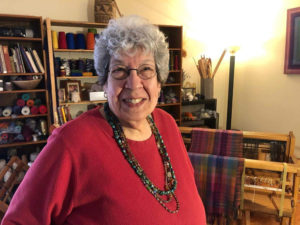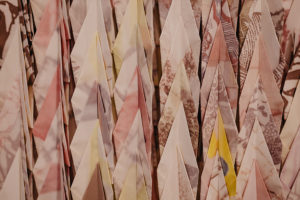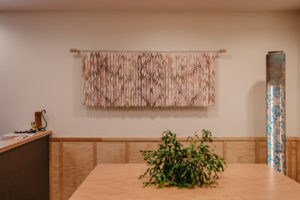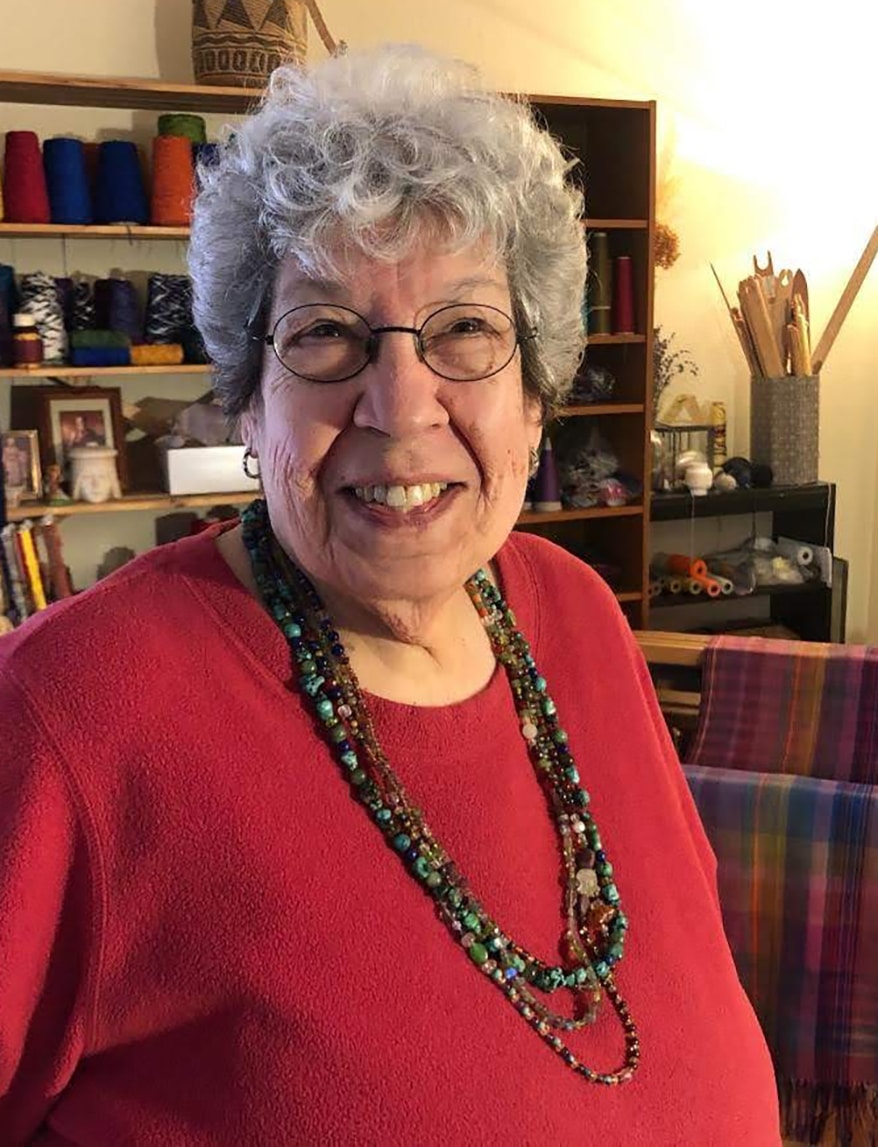 Bonnie Tarses demonstrates the process of infusing meaning into every individual thread in the creation of “Color Horoscope Weaving.”
Bonnie Tarses demonstrates the process of infusing meaning into every individual thread in the creation of “Color Horoscope Weaving.”I FIRST MET the illustrious Bonnie Tarses when she visited my digital textile printing studio almost a year ago. Little did I know I’d be spending time with the most tech savvy 80-year-old woman and digital print enthusiast I’d met in my career.
A graduate of the Rhode Island School of Design, Bonnie has been innovating the art of weaving for more than 60 years. She’s a master at her craft, but also unafraid of embracing new ideas, techniques, and technologies – a perspective that both surprised and delighted me. Her first experiences with digital textile printing started with Spoonflower and she’s evolved her relationship to the digital practice over the past decade.
When I first hosted her at the Western Sensibility studio, I was curious how familiar she’d be with modern textile practices. The experience couldn’t have been more magical. I recently sat down with Bonnie to discuss her first time seeing digital textile printers in action and how it has impacted her work.
Kathryn Sanders: What was your initial reaction to seeing the digital textile printing process in person?
Bonnie Tarses: I was totally blown away when I saw the digital textile printing process! It was as if a lifetime wish had miraculously been granted. I majored in Textile Design at RISD in the early ’60s, long before the digital age. Surface design for the industry was an extremely tedious process, and because my drawing skills were merely adequate, I veered toward weaving. I was required to learn both, but my surface design skills lay dormant until the 21st century when I encountered computers, Photoshop, and Spoonflower. Having the capacity to transform detailed images of my weaving into printed cloth literally at my fingertips is my wildest dream!
KS: In your practice, do traditional weaving methods and digital tools coexist?
Advertisement
BT: Short answer: I am a weaver. I can weave together most anything.
Most weavers, who use a computer, use it as a pattern generator. One can create a lifetime of weaving drafts in an afternoon, but then one has to weave them. I am doing the opposite: I began taking decades of images of my weavings and manipulating them (mainly mirror imaging, reducing size, and repeating) the way I had been taught at RISD decades ago, and printing a finished design. Once I finally learned how to do this on Photoshop, one weaving could become the springboard for literally dozens of surface designs. And then I discovered Spoonflower! Every spare dollar went into printing. I was aiming to print silk scarves, although I could never get the results I was looking for. I was living in Seattle at that time, but I moved back to Missoula in 2010 and put my obsession aside while I readjusted to the Montana lifestyle. But always in the back of my mind was the dream of digitally printing detailed images of my weavings.
KS: As a storied weaver, what is it like to encounter new textile technologies? Do new tools impact your process?
BT: I dreamed of this day, of encountering new technologies. It feels like I have been preparing all these decades but not knowing what I was preparing for. I can still feel the sweat and tears of creating a repeat pattern by hand, and then being able to do that very same process in a minute! That was one of the most impactful moments of my weaving/artist life. I felt the exact same feeling when I first stepped inside of Western Sensibility. Now textile design, origami, and dye sublimation printing are all woven together in my imagination. Through this new technology I will be able to weave a legacy.
KS: Do you think weaving is categorized differently than other fiber art – including digital textile printing?
BT: I think branding all the soft crafts as fiber art has helped to elevate felting, quilting, basketry, and nonfunctional weaving. But functional weaving is still not considered art. It has been a six-decade uphill struggle to find a way to break into the art world. I remember hearing an art museum curator saying he would never have weaving in his museum except for maybe digital. He dismissively inspected the handwoven shawl I was wearing and said, “Nice edges.” But now that I recall that moment, I believe the word “digital” entered my brain and inspired me to create woven art.
Advertisement
KS: When you were visiting the studio, you had a beautiful and strong reaction to the paper printing step of the dye sublimation process. What was it about the paper that intrigued you? Did you immediately connect it with your passion for origami?
BT: I was already deep into origami and origami paper, so the sight of all that fabulous paper in the recycle bin took my breath away. I wish someone had taken a picture of my facial expression. I almost forgot about printing on fabric and immediately asked if I could have some of the paper. I just have to say, it is great for folding origami! I sampled some of it that very night and was back for more the next day.
KS: The tactile nature of weaving is quite like that of folding origami. What sparked your interest in integrating origami into your art practice?
BT: I can’t resist telling how I got into origami. It’s such a good story. I wanted to keep the pigeons from making a mess on my steps and was seeking an aesthetic deterrent. I thought that learning to fold origami cranes and stringing them so they would twist and turn in the air would do the trick. That was seven years ago.
Although I no longer live in that house, the cranes are still keeping the pigeons away. While I was learning to fold, I was told the Jeannette Rankin Peace Center was folding cranes to commemorate the 70th anniversary of the bombing of Hiroshima and Nagasaki. I decided to join in because I was already folding cranes. Soon, I was teaching a weekly class for novice crane folders. JRPC decided they wanted to use recycled paper, so I ended up cutting 5000 sheets of origami paper from old National Geographic magazines. Writing this has made me realize that from early on I was involved with creating unique origami paper designs! During all that cutting and folding, someone told me about a Japanese legend that if one folds 1000 cranes, strings them on a string, and gives them as a gift, a wish is bestowed. Then I got word that a dear friend of mine was terminally ill. I was at a loss, powerless and helpless. When I recalled the story about folding 1000 cranes and getting a wish, I launched into folding my first 1000 crane project. When my friend came home from the hospital, 1000 cranes folded from National Geographic magazines were hanging on her front porch. I couldn’t have said or done anything more heartfelt and meaningful. I am currently working on my 31st senbazuru (the Japanese word for folding a thousand cranes as a gift). It has been life changing to be involved in creating these unique offerings.
They say that you have to do 10,000 of something to become a master. When I reached 10K before the pandemic, something shifted. I began to create patterns. The cranes morphed into pixels. The next 10 installations not only became pictorial, but they also came to resemble textiles. People couldn’t believe they were made from folded paper.
Advertisement
KS: I’m still in awe of your generosity and decision to create a 1000 crane origami installation for Western Sensibility from our post-transferred dye sublimation paper. How did this installation differ from others you’ve done?
BT: Every time I fold 1000 cranes, something different emerges. As I said earlier, when I saw the recycled printed paper on my initial tour of Western Sensibility, my mind started calculating. This was indeed the first time that I saw a pile of paper and said I want to fold 1000 cranes with this paper, but that is exactly what happened. Then I told you my idea/plan and we immediately picked out a wall for the installation. I started folding an easy schedule of 50 cranes per day for 20 days. Just like weaving, the first question most people ask is “How long does it take you?” and I like to say roughly 100 hours.
KS: You consider yourself “an artist who happens to weave.” Can you expand on that idea?
BT: Weaving is all about time. Weaving is time made visible. The weaving journey is infinite and takes lifetimes to travel. All the lessons in life can be learned in weaving. The greatest lesson I learned was back in the mid-’70s when I shared a studio with a wood carver. As I was weaving along, I noticed I had made a weaving error and I would have to unweave about six inches. I cursed and shouted, “I hate to unweave!” The woodcarver stopped sanding and said, “Many the time, I wish I could un-carve.” I knew in that moment the greatest power in weaving is there is no mistake you cannot fix if you take the time, and at the same time, knowing there are an infinite number of possible mistakes. Weaving is the lens through which I view life. The craft of weaving is to have “nice edges,” but the art is everything in between.
About Bonnie Tarses – The “Artist Who Happens to Weave”
In her more than 61 years as an artist who works in colorful yarns, weaving master Bonnie Tarses continues to draw her inspiration from ancient ethnic textiles, color symbolism, and the nonverbal language of color, woven, she says, as “joyous prayer.”
A graduate of the Rhode Island School of Design, Bonnie has been weaving since 1960. For 30 years, from 1980 to 2010, she was artist/owner of her own studio in Seattle, creating one-of-a-kind, beautiful, and functional cloth. Now, back in her beloved Montana to continue her weaving journey, she specializes in private commissions and collaborative works for the betterment of the community. She shares her love of weaving by presenting artistically motivating lectures and workshops throughout the US and Canada. Bonnie was recently named “A Living Treasure” by The Montana Association of Weavers and Spinners.
Visit her website bonnietarses.com for additional examples and inspiration.
PHOTO GALLERY (4 IMAGES)
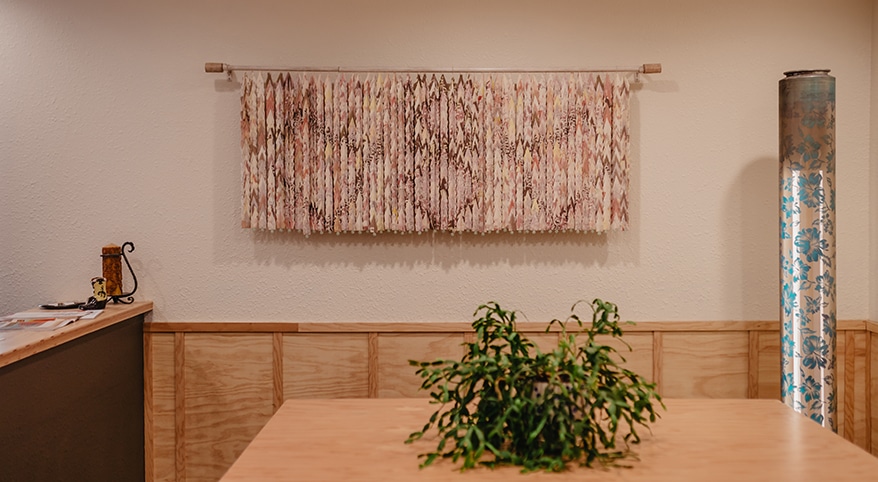 Bonnie Tarses’ 1000 crane installation made from Western Sensibility’s post-transferred dye sublimation paper. This piece features paper with designs from multiple contemporary artists all woven together by Bonnie to echo digital and analog textile processes.
Bonnie Tarses’ 1000 crane installation made from Western Sensibility’s post-transferred dye sublimation paper. This piece features paper with designs from multiple contemporary artists all woven together by Bonnie to echo digital and analog textile processes.

 Best of Wide Format2 months ago
Best of Wide Format2 months ago
 Best of Wide Format2 months ago
Best of Wide Format2 months ago
 Columns2 months ago
Columns2 months ago
 Blue Print2 weeks ago
Blue Print2 weeks ago
 Best of Wide Format2 months ago
Best of Wide Format2 months ago
 Best of Wide Format2 months ago
Best of Wide Format2 months ago
 Best of Wide Format2 months ago
Best of Wide Format2 months ago
 Best of Wide Format2 months ago
Best of Wide Format2 months ago
 Bonnie Tarses demonstrates the process of infusing meaning into every individual thread in the creation of “Color Horoscope Weaving.”
Bonnie Tarses demonstrates the process of infusing meaning into every individual thread in the creation of “Color Horoscope Weaving.”